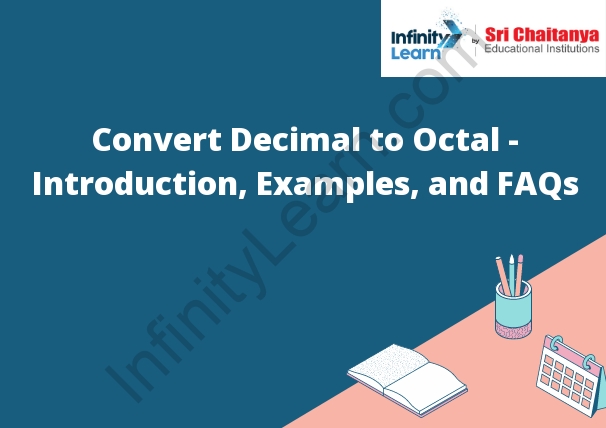Table of Contents
How to Convert Decimal to Octal?
To convert decimal to octal, divide the decimal number by 8 and take the remainder. Write the remainder below the number, and drop the decimal point.
The octal numeral system, or oct for short, is the base-8 number system, and uses the digits 0 through 7. In octal, the number 26 is equal to 10, because 2 × 8 = 10.
To convert a decimal number to octal, divide the decimal number by 8, and keep track of the remainder. Write down the number that corresponds to the remainder, followed by the symbol for octal. For example, to convert the decimal number 26 to octal, divide 26 by 8, and get a remainder of 2. Write down the number 2, followed by the symbol for octal, which is “0”. So the octal representation of 26 is “02”.
To convert a octal number to decimal, divide the octal number by 8, and keep track of the remainder. Write down the number that corresponds to the remainder, followed by the symbol for decimal. For example, to convert the octal number “02” to decimal, divide 02 by 8, and get a remainder of 2. Write down the number 2, followed by the symbol for decimal, which is a “point”. So the decimal representation of “02” is “2.0”.
For example, to convert the decimal number 123 to octal:
123 / 8 = 15 remainder 3
15 / 8 = 1 remainder 5
1 / 8 = 0 remainder 1
The octal number would be 153.

An Overview of Octal
Octal is a number system with base 8. This means that there are 8 digits in the octal number system: 0, 1, 2, 3, 4, 5, 6, and 7. Octal numbers are written with a prefix of 0 (zero) followed by the digits in the number. For example, the octal number 543 would be written as 0 543.
Octal numbers can be used to represent binary numbers. In binary, there are only 2 digits: 0 and 1. To convert a binary number to octal, divide the binary number by 8 and write the remainder as the octal number. For example, the binary number 1111 would be converted to octal as 3 (because 1111 ÷ 8 = 1 remainder 3).
Octal can also be used to represent hexadecimal numbers. In hexadecimal, there are 16 digits: 0, 1, 2, 3, 4, 5, 6, 7, 8, 9, A, B, C, D, E, and F. To convert a hexadecimal number to octal, divide the hexadecimal number by 16 and write the remainder as the octal number. For example, the hexadecimal number 1AF would be converted to octal as 25 (because 1AF ÷ 16 = 11 remainder 5).
Converting the Decimal to Octal
To convert the decimal number 12 into octal, we first divide it by 8 to get the quotient 1 and the remainder 2. We then write 1 as the first octal digit, followed by the number 2 (which is the remainder). So the octal representation of 12 is 1 2.
Conversion from Decimal to Octal Number System
To convert a decimal number to octal number system, divide the decimal number by 8 and take the remainder. Write the remainder as the octal number.
Example:
Convert the decimal number 153 to octal number system.
153 ÷ 8 = 19 remainder 5
Therefore, the octal number for 153 is 5.
(a) Converting With Remainders (for Integer Part)
Converting a decimal number to an integer with a remainder can be done by following these steps:
Step 1: Divide the decimal number by the number that will be the largest power of 10 that is less than or equal to the decimal number.
Step 2: Write down the number that is the result of Step 1 and the remainder of the division in Step 1.
Step 3: Repeat Step 1 and Step 2 for the next largest power of 10 that is less than or equal to the decimal number.
Step 4: Write down the number that is the result of Step 3 and the remainder of the division in Step 3.
Step 5: Write the number that is the result of Step 4 as the integer part of the decimal number and write the number that is the result of Step 3 as the decimal part of the decimal number.
EXAMPLE: Convert the decimal number 0.625 to an integer with a remainder.
Step 1: Divide 0.625 by 10.
0.625 ÷ 10 = 0.0625
Step 2: Write down the number that is the result of Step 1 and the remainder of the division in Step 1.
0.0625 and 5 ÷ 10 = 0.625
Step 3: Repeat Step 1 and Step 2 for the next largest power of 10 that is less than or equal to the decimal number.
0.0625 and 100
(b) Converting With Remainders (for Fractional Part)
To convert a decimal number to a fractional number with remainders, divide the decimal number by the greatest possible number that will divide evenly into it. Write the division problem and the answer with the remainders above the division problem.
For more visit Numeral System | List of Numeral System – Unary, Binary, octal and Decimal Number System






